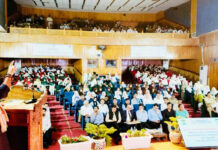In a monumental step towards healing and reconciliation, the Arde Nareshwar Temple in Nadi Marg has reopened its doors to devotees after two long, tumultuous decades. This reopening not only marks the revival of a sacred space for worship but also symbolizes the triumph of faith over adversity, hope over despair, and unity over division. For two decades, the temple remained silent—a stark reminder of the socio-political upheaval that gripped the Kashmir Valley. The temple’s closure mirrored the exodus of Kashmiri Pandits, who were forced to flee their ancestral homes in the face of insurgency and violence. The reopening of Arde Nareshwar Temple is, therefore, much more than the restoration of a religious site; it is a testament to the undying resilience of a community that held on to its cultural and spiritual roots, despite immense challenges. The return of devotees to this sacred site is a poignant reminder of the rich pluralistic heritage of Kashmir. For centuries, the Valley has been a melting pot of various religious and cultural influences, with temples, mosques, and shrines coexisting in harmony. The Arde Nareshwar Temple, dedicated to Lord Shiva, has been an integral part of this spiritual landscape, drawing pilgrims from all walks of life. Its reopening revives not just the religious significance of the temple but also the idea of Kashmir as a land of inclusivity and peaceful coexistence. While this is a moment of celebration, it is also a time for reflection. The scars of the past still run deep, and the reopening of the temple serves as a reminder of the work that lies ahead in rebuilding trust, fostering communal harmony, and ensuring the safe return of displaced communities. It is essential that the reopening of religious sites such as Arde Nareshwar Temple be accompanied by sincere efforts from the government and civil society to create an environment where people of all faiths can live without fear and prejudice. The reopening of the Arde Nareshwar Temple is not just a spiritual milestone but also a significant socio-political development. It signals a new chapter in the ongoing efforts to restore peace and normalcy in the Valley. The government’s support in facilitating this reopening, along with the efforts of local communities, indicates a growing commitment to reviving Kashmir’s cultural heritage and safeguarding its diversity. However, the path to lasting peace and harmony will require more than symbolic gestures. Real progress will depend on sustained dialogue, rehabilitation efforts, and policies that address the concerns of displaced communities, including the Kashmiri Pandits. While the reopening of Arde Nareshwar Temple is a positive step, it must be followed by continued efforts to rebuild homes, provide security, and promote understanding between communities. As the temple bells ring once again, the sound carries the hopes and prayers of many who dream of a Kashmir where temples, mosques, and churches are not just places of worship but symbols of the unity that once defined the Valley. The reopening of the Arde Nareshwar Temple is a beacon of that hope—a reminder that even in the darkest of times, faith and resilience can lead the way toward a brighter, more inclusive future.

Dogra Herald is the media of J & K, breaking language and geographical barriers, connecting J & K to the rest of India.
0191 245 4946
info@dograherald.com
Latest articles
India has made rapid strides inhealthcare in past 10 years: LG Sinha
DH NEWS SERVICEjammu, Mar 11Lieutenant Governor Manoj Sinha today inaugurated the Shri Birendra Rai Hospital at Areraj, Motihari, Bihar.The Lieutenant Governor congratulated...
Kavinder criticizes NC’s demand to restoreholiday on Sheikh Abdullah’s Birth Anniversary
DOGRA HERALD BUREAUjammu, Dec 5Senior BJP leader and former Deputy Chief Minister, Kavinder Gupta, today criticized the National Conference's demand to restore...
Only ‘Modi Ki Guarantee’ can fulfil aspirations of people of Bharat: Bali Bhagat
DOGRA HERALD BUREAUJAMMU, Mar 5Bali Bhagat, Election In-charge for Nagrota constituency and former Minister, emphasised that only Modi Ki Guarantee can fulfil...




























